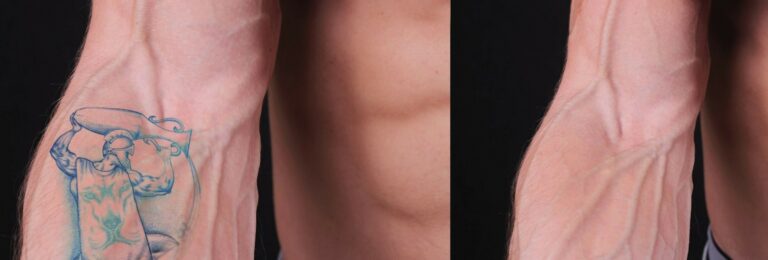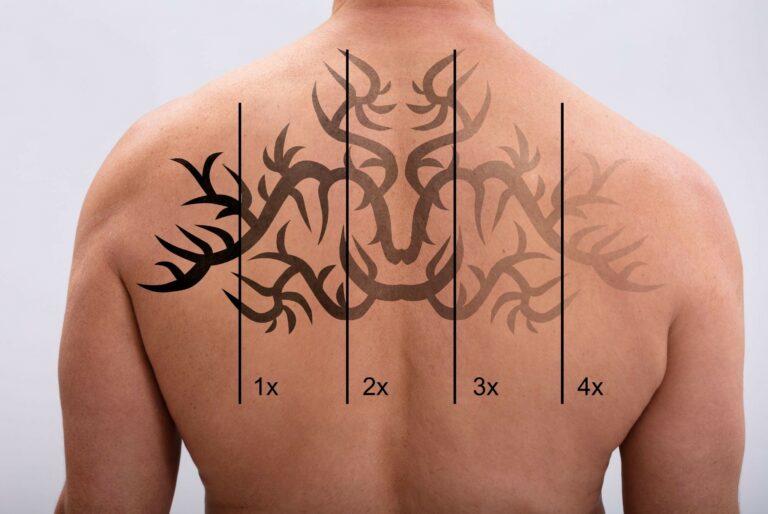Enhancing Tattoo Removal Results
The Popularity of Tattoo Removal
Tattoos have become increasingly popular over the years, with more and more people getting inked. However, as times change and interests shift, many people are opting to have their tattoos removed. Whether it’s due to a change in lifestyle or simply a desire for a fresh start, there are various reasons why someone may want their tattoo removed.
Currently, laser tattoo removal is the most common method used for removing tattoos. This procedure involves using high-intensity light beams to break down the ink particles in the skin.
While effective, tattoo removal can be a lengthy process that requires multiple sessions. But despite its time-consuming nature, it hasn’t stopped individuals from seeking out this service.
Why Enhancing Tattoo Removal Results is Important
While tattoo removal technology has improved over time, not every patient sees optimal results from the treatment. In some cases, scar tissue may form or parts of the tattoo may remain visible even after multiple sessions. For those who seek complete erasure of their unwanted tattoos and minimal scarring, enhancing tattoo removal results is essential.

There are several ways to achieve better results from your tattoo removal treatment. From choosing the right type of laser to proper aftercare techniques and lifestyle changes before treatment begins – everything plays an important role in enhancing your results.
If you want to enhance your chances of completely removing an unwanted tattoo without significant scarring or discoloration left behind you need to take proactive steps like researching qualified professionals with ample experience in this particular field; ensuring that you choose laser technology that works best on specific colors used in your tattoo; prepping yourself physically by taking care of skin health prior-to-treatment etc. Enhancing your chances during and post-treatment means ensuring that all aspects are covered when going through such a procedure – including pre-care measures like avoiding sun exposure and maintaining a healthy lifestyle which will help your body to heal faster and provide better chances of success.
To summarize
Tattoo removal has become increasingly popular, with people seeking an effective and safe way to remove unwanted tattoos. With the advancements in laser technology, tattoo removal has become more accessible and less invasive than ever before. However, it’s important to remember that not all tattoo removal treatments are created equal.
Enhancing tattoo removal results is essential for those who want complete erasure of their tattoos without significant scarring or discoloration left behind. By taking proactive steps like researching qualified professionals with ample experience in this particular field, choosing the right laser technology for specific tattoo colors, prepping yourself physically by taking care of skin health prior to treatment, etc., you can enhance your chances during and post-treatment – ultimately ensuring that all aspects are covered when going through such a procedure.
Understanding Tattoo Removal Tattoo removal is the process of eliminating unwanted tattoos from the skin’s surface. The most common tattoo removal methods are laser, surgical excision, and dermabrasion.
Each method works differently and has different pros and cons. In this section, we will discuss these three methods of tattoo removal in detail to help you understand which option might be best for you.
Different Types of Tattoo Removal Methods
Laser Tattoo Removal: This is the most popular method of tattoo removal.
The laser emits a high-intensity light beam that targets the ink particles in the skin. The ink particles absorb the laser energy, causing them to break into smaller pieces that can be eliminated by the body’s immune system.
Multiple sessions are usually needed for optimal results. Surgical Excision:
In this method, a dermatologist will cut out the tattooed area of the skin and then sew up the wound with stitches. This method is usually reserved for smaller tattoos as larger ones would require extensive surgery or skin grafting.
This procedure can leave a scar where the tattoo was removed. Dermabrasion:
This method involves using a handheld device to sand down or abrade away layers of skin where tattoo ink resides until it fades away entirely. Dermabrasion can be particularly effective at removing superficial tattoos but may require several treatments to achieve optimal results.
How Each Method Works and Their Pros and Cons
Laser Tattoo Removal: The primary advantage of laser tattoo removal is that it can remove tattoos without scarring.
However, there are still some risks involved such as changes in pigmentation or allergic reactions to treatment, making it not suitable for everyone despite its popularity. Surgical Excision:
This technique provides immediate results however it is invasive surgery which means there could be scarring left from where your doctor cut out your unwanted ink. Dermabrasion:
The biggest advantage of dermabrasion over other methods is that it works on all skin types. This procedure can remove deep tattoos and it is known to have a lower risk of scarring than surgical excision, but the recovery time will be longer.
Factors That Affect the Success of Tattoo Removal
Size: The size of the tattoo you want to remove affects how long the removal process will take and how successful it will be. Color: The color of the ink used in your tattoo also affects how successful laser removal treatment may be. Darker colors such as black or red are easier to remove, whereas lighter colors such as yellow or green can make it harder for lasers to penetrate and break down ink particles
Age: Older tattoos are usually easier to remove than newer ones because they have already started to fade naturally. Location: Tattoos that are located on areas with more blood flow, like the arms or legs, are generally easier to remove than tattoos on areas with less flow like fingers, toes, or ears.
Understanding these factors and methods for tattoo removal is crucial for anyone considering getting rid of their unwanted ink. Consult a professional dermatologist or laser technician before choosing a method so that you can make an informed decision about which option is best suited for your situation.
Preparing for Tattoo Removal
Consultation with a Professional Dermatologist or Laser Technician
The first step in preparing for tattoo removal is to schedule a consultation with a professional dermatologist or laser technician. During this consultation, the professional will evaluate your skin and discuss which tattoo removal method is best suited for you based on factors such as the size, color, age, and location of your tattoo. They will also explain the risks and benefits of each method, as well as how many treatment sessions you may need to achieve optimal results.
It is important to choose a reputable clinic or practitioner who has experience in performing tattoo removal procedures. Ask for referrals from friends or family members who have undergone laser treatments before, and read reviews online to ensure that you are choosing someone who has a good track record of success.
Proper Skin Care Before and After Treatment (Hydration, Sun Protection)
To prepare your skin for tattoo removal treatment, it is important to keep it hydrated and protected from the sun. Drink plenty of water in the days leading up to your appointment to ensure that your skin is well-hydrated. Moisturize regularly using a non-scented lotion to keep your skin soft and supple.
On the day of treatment, avoid wearing any lotions or creams on the area being treated. This will allow the laser or other treatment method used by the technician to penetrate deeper into your skin without obstruction.
After treatment, it is essential that you protect your skin from further damage by avoiding direct sunlight as much as possible. Cover up with protective clothing or apply sunscreen with an SPF of at least 30 if you must go outside during daylight hours.
Lifestyle Changes to Improve Overall Health (Diet, Exercise)
Improving overall health through diet and exercise can also enhance tattoo removal results. Eating a nutritious diet rich in antioxidants, vitamins, and minerals can help your skin heal faster after treatment.
Incorporating regular exercise into your routine can also improve circulation, which can aid in the healing process. Additionally, quitting smoking and reducing alcohol consumption can also be beneficial.
Smoking damages the skin by decreasing blood flow and promoting premature aging. Alcohol consumption dehydrates the body, which can impede the healing process.
By making these lifestyle changes before and after tattoo removal treatment, you are setting yourself up for success. A healthy lifestyle will help your body to heal faster and ensure that you achieve optimal results from your tattoo removal procedure.
Enhancing Tattoo Removal Results
Laser Treatment: Choosing the Right Laser Technology for Specific Tattoo Colors
Laser technology has become one of the most widely used methods for tattoo removal due to its high success rates and minimal invasiveness. However, not all laser devices are created equal when it comes to removing different colors of ink. For example, Q-switched lasers are highly effective for removing dark-colored tattoos such as black or blue ink, but may struggle with lighter colors like yellow or green.
Alternatively, picosecond lasers have shown promising results in targeting a broader range of ink colors due to their shorter pulse durations and higher energy levels. When considering laser tattoo removal, it is important to consult with a professional dermatologist or laser technician who can assess your tattoo and recommend the best laser technology for your specific needs.
Laser Treatment: Multiple Sessions for Optimal Results
Tattoo removal through laser treatment typically requires multiple sessions spaced several weeks apart. The number of sessions required varies depending on various factors such as tattoo size, color, and age. It is important to note that while some results may be visible after the first session, full removal can take several months or even years of consistent treatment.
Patience is key when it comes to laser tattoo removal. Additionally, it is essential to follow all post-treatment instructions provided by your dermatologist or technician in order to achieve optimal results.
Laser Treatment: Aftercare Tips to Promote Healing and Minimize Scarring
After each session, proper aftercare can help promote healing and minimize scarring. It is recommended to keep the treated area clean and dry while avoiding any abrasive materials that could irritate the skin.
Applying a topical ointment such as petroleum jelly can also aid in preventing infection and promoting healing. Additionally, keeping the area protected from the sun and other potential irritants can help minimize scarring and promote healthy skin.
Surgical Excision: Proper Wound Care After Surgery
Surgical excision is another method for tattoo removal that involves cutting out the tattooed skin and sewing the remaining skin back together. While this method is highly effective for small tattoos, it can result in more scarring than other methods.
Proper wound care after surgery is essential to ensure proper healing and minimize scarring. Keeping the area clean and dry while regularly changing bandages is important to prevent infection.
Your dermatologist or surgeon may also recommend using compression garments or silicone sheets to aid in healing and reduce scar formation. Following all post-operative instructions provided by your healthcare professional can help ensure successful healing.
Surgical Excision: Importance of Following Post-Operative Instructions
Following post-operative instructions provided by your healthcare professional is critical in achieving optimal results after surgical excision. These instructions may include avoiding certain activities that could disrupt the healing process, such as heavy lifting or exercise.
Additionally, it may be recommended to keep the treated area elevated to reduce swelling and promote circulation. Proper medication management, including pain management, will also be discussed with your doctor to ensure a comfortable recovery process.
Surgical Excision: Scar Management Techniques
While surgical excision can result in more scarring than other methods, there are various techniques that can be used to minimize visible scars. These techniques may include using specialized dressings or silicone sheets during the healing process or undergoing further treatments such as laser therapy or dermabrasion after sufficient healing has occurred.
It is important to discuss scar management techniques with your dermatologist or surgeon prior to undergoing surgical excision in order to set realistic expectations for results. By following all recommended post-operative instructions and utilizing these techniques, you can enhance your tattoo removal results while minimizing visible scarring.
Dermabrasion: Understanding the Procedure and How it Works
Dermabrasion involves using a specialized tool to remove the outer layers of skin in order to remove a tattoo. This method requires significant downtime and may result in more scarring than other methods.
During the procedure, anesthesia will be used to minimize discomfort. The area surrounding the tattoo will then be numbed with a local anesthetic before the skin is carefully removed through the use of the dermatological tool.
Dermabrasion: Pre-Treatment Preparation for Best Results
Prior to undergoing dermabrasion, proper pre-treatment preparation is essential for successful results. This may include abstaining from certain medications or supplements that could increase bleeding or delaying treatment if you are experiencing any active skin conditions. It is important to discuss any concerns or questions with your dermatologist prior to undergoing dermabrasion in order to ensure optimal results and reduce potential complications.
Dermabrasion: Aftercare Tips to Minimize Scarring
After treatment, proper aftercare can help promote healing and minimize scarring. It is recommended that patients avoid direct sunlight while keeping the treated area clean and dry.
Additionally, wearing loose clothing over the treated area can help prevent irritation or rubbing that could disrupt healing. Your dermatologist may also recommend specific ointments or creams to aid in healing and reduce potential scarring.
Conclusion:
After reviewing the different methods of tattoo removal and the various ways to enhance their results, it is clear that achieving successful tattoo removal is a process that requires patience, dedication, and attention to detail. Whether you choose laser treatment, surgical excision, or dermabrasion, there are steps you can take to improve your chances of success and minimize the risk of scarring. It is important to remember that tattoo removal is not an exact science and results can vary depending on factors such as the age of the tattoo, its size, color, and location on your body.
Therefore it is best to consult with a professional dermatologist or laser technician who can guide you through the process and provide tailored recommendations for your specific case. If you are considering having a tattoo removed or lightened, it is important to be realistic about what can be achieved.
Although complete removal may not always be possible, significant fading can often be achieved with multiple treatments over time. It’s also important to maintain a healthy lifestyle by eating well, exercising regularly, and taking good care of your skin before and after treatment.
It’s essential to choose a reputable clinic with trained professionals who have experience in providing quality care before, during, and after treatment. By following these tips and working closely with your provider on an individualized plan for enhancing tattoo removal results — success is more likely than ever!
References
Medical Disclaimer:
The information provided on this website regarding tattoo removal techniques is for general informational purposes only. It is not intended to be a substitute for professional medical advice, diagnosis, or treatment. Always seek the advice of a qualified healthcare professional regarding any medical condition or concerns, including tattoo removal.
The content presented on this website should not be interpreted as endorsing or promoting any specific tattoo removal technique, product, or service. The effectiveness, safety, and suitability of tattoo removal methods can vary depending on individual circumstances and factors. Therefore, it is crucial to consult with a medical professional or qualified specialist before making any decisions or embarking on any tattoo removal procedure.
The website does not guarantee the accuracy, completeness, or reliability of the information provided. Reliance on any information from this website is solely at your own risk. The website and its owners, authors, and contributors shall not be held liable for any damages or consequences arising from the use of the information provided.
It is important to note that medical practices and standards may change over time, and the information provided on this website may not always reflect the most up-to-date research or guidelines. Therefore, it is recommended to consult with healthcare professionals or reputable sources for the latest information and advice on tattoo removal techniques.
If you experience any adverse reactions, complications, or concerns during or after a tattoo removal procedure, promptly seek medical attention. Only a qualified healthcare professional can assess your specific situation and provide appropriate advice and treatment.
By using this website, you acknowledge and agree to the above disclaimer, and you understand that the website and its owners, authors, and contributors cannot be held responsible for any decisions or actions taken based on the information provided.




